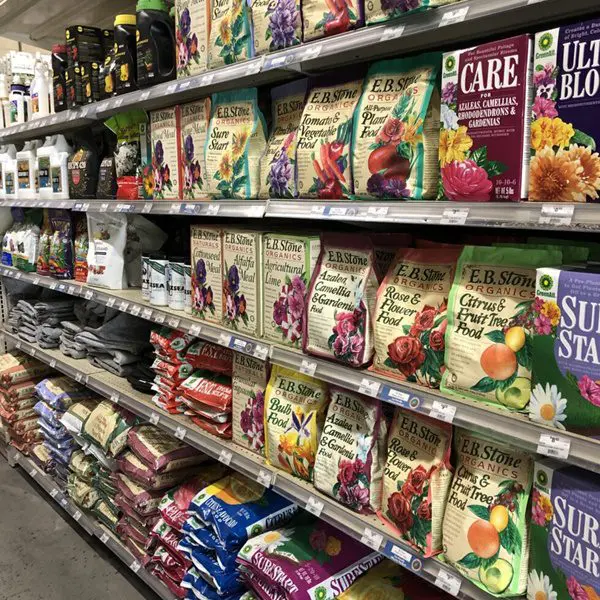Where to begin? Well, like all living organisms, plants need nutrients. They take available nutrients from soil and water. According to Wikipedia, “fertilizer” is any material of natural or synthetic origin applied to soil or to plant tissues to supply plant nutrients. 17 essential elements are needed for plants to grow to their full genetic potential. Of these, 14 are absorbed through the soil, while the remaining come from air, sunlight and water. The primary nutrients required are nitrogen, phosphorus and potassium (N,P,K respectively) as well as other trace minerals and micronutrients.
The Big 3
Let’s start with N – P – K, the “Big 3” primary chemical elements in commercial fertilizers, Nitrogen, Phosphorus and Potassium. These elements are found in natural and organic sources: compost, animal manure, harvested minerals and byproducts such as fish processing waste or blood meal from animal slaughter. These nutrients are the basis of processed fertilizers and come in two forms: synthetic and natural (organic). Either form is available in dry, pelletized (slower, time-released) or liquid for application to the soil and/or directly to the plant.
Remember Up, Down, and All-Around
Nitrogen is essential to the formation of protein, which makes up much of the tissues of most living things. Nitrogen will produce leafy, green leaves, stimulating the production of chlorophyll (the main chemical involved in photosynthesis – how plants convert sunlight to food. Organic nitrogen providers include: dried blood, blood meal, fish emulsion and seaweed extract.
Phosphorus improves the plant’s ability to use and store energy. It’s essential to the process of photosynthesis. It is needed for a healthy root system, buds and flowers and improves vitality. Organic phosphorus providers include: Bone meal, rock phosphate.
Potassium affects overall vitality, makes carbohydrates, and provides disease resistance. Potassium builds strong cells within the plant tissue, helping plants withstand various stresses, like heat, cold, pests and diseases. Organic Potassium providers include: potash.
What’s In A Number?
Here is where it can get complicated. Fertilizer marked as 10-10-10 is a balanced blend of equal portions of Nitrogen, Phosphorus and Potassium. If you purchased a 3-pound bag, 1 pound (or 10%) would be Nitrogen (N¹), 1 pound would be phosphorus (P²O5), and 1 pounds would be potassium (K²O). The remaining 70% is simply filler or inert ingredients (in the case of synthetic fertilizer – salts) which are there mostly to help disperse the chemicals.
If you are looking to boost flower production, you want a mix like 15-30-15, which is high in flower-developing phosphorus. If you want to encourage top growth, choose a mix like 25-6-4, which is high in nitrogen.
The Other Nutrients
Some trace elements are more important than others, but each nourishes a plant in its own way. The main trace elements in fertilizers are calcium, magnesium, iron, copper, manganese, zinc, molybdenum, boron, and sulfur. If any of these elements are lacking, a plant may show characteristic deficiency symptoms. An iron deficiency, for instance, causes chlorosis (yellow leaves with green veins), which is easily corrected with a dose of chelated iron.
Organic vs. Synthetic
Organic fertilizers release slowly. They need time to break down. For example: blood meal and many types of manure – can be available to plant roots within two to six weeks, alfalfa, clover and rye – can be available to plant roots within two to six months, fish emulsion – can be available to plants quickly but are often used up within two weeks. If you have the luxury of holding your Begonia medium before using, here are some ideas for adding a natural compost to your soil before you pot up, or add to your potted plants.
- Eggshells (crushed): provide calcium. Crush and sprinkle over potting media. Chicken bones (cooked, dried, crushed): provides calcium. Crush and sprinkle over potting media.
- Epsom salts: provide magnesium. Dilute one teaspoon of salts in one gallon of water and water as usual.
- Dairy milk or buttermilk provides nitrogen. Use one part milk to three parts water and water as usual.
- Molasses: provides potassium. Add one teaspoon of molasses to one quart of water and water as usual.
- Potato water (from boiled potatoes): provides potassium and phosphorus. Use room temperature left-over potato water in place of regular water and water as usual.
- Brown rice water: provides thiamin, niacin, folic acid, and riboflavin. Use left-over room temperature brown rice water to water in place of regular water.
- Teabags (steeped): provide nitrogen. Open the room temperature used teabag and sprinkle the contents over the potting media.
- Worm Tea and Rabbit Pellets (Bunny Balls) can be added to the soil without breaking down.
Synthetic fertilizers are water-soluble and the plant will take up the fertilizer right away. If too strong, the delicate root systems of begonias will burn. To avoid toxic concentrations of salts, apply to moist soil. Then use plain water for several waterings after applying to flush out excess salts.. A dilution of ½ to ¼ the normal application guidelines is typical for begonias and orchids. Some will use this dilution each watering time. Others will use this dilution 2 times a month or every other watering. Note: Synthetic fertilizers do nothing for soil condition as no organic content is added to support microbiological life in the soil.
FINAL THOUGHTS – SPECIFICALLY BEGONIAS:
Fertilizing seeds, tiny seedlings and new cuttings will cause fertilizer burn. NO-NO!
Begonias should be fertilized only when they are actively growing.
To encourage bloom use a high bloom, lower nitrogen formula to encourage more flowers and less rampant plant growth.
When bloom production stops and the plants enter their dormancy stage, withhold fertilizer and let your plants rest until their next growing season starts. The dormancy period usually starts in October and growth starts up again in Spring.
Begonias don’t grow or use fertilizer under 60 degrees F.


